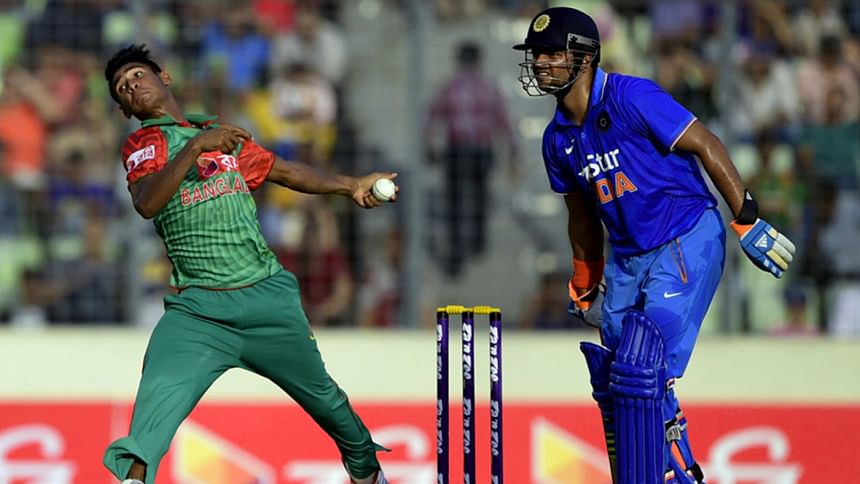Mustafizur and the art of the cutter

At the international level any bowler who operates in the mid-to-late 120kph range gets little respect. That's why it wasn't surprising to see the Indians not take much notice of the wiry left-arm seam bowler who ran in during the first ODI of India's recent tour to Bangladesh. That was Mustafizur Rahman range.
If you don't have pace, you must swing the ball prodigiously to make up for it, but Mustafizur didn't have swing either. The odd ball would come back in to the right-handers, but not extravagantly enough to set warning bells ringing. The last thing that can save you in the absence of pace and swing is if you generate disconcerting bounce, but to get that on slow, low subcontinental pitches, you must be as tall as Mohammad Irfan, and Mustafizur is nowhere close. He should have been easy prey from the looks of him. Yes, he has a quick arm action and an effective slower one, but is that enough to succeed against top-quality international batsmen?
No wonder it took everyone by surprise when Mustafizur took five wickets on ODI debut. I, for one, was convinced the Indians would figure him out in the following games. How wrong I was. Not only did he fox India through the three-match series, he also left the South Africans searching for answers in the one after, making everyone sit up and take notice.
What makes him a difficult bowler to handle? Mustafizur is like any other left-arm seam bowler when the ball is new, for he tries to bring it back in to the right-handers, with the odd delivery holding its line and creating doubt. His speeds were worth noting in the matches against South Africa, where he began to clock close to 140kph. Now the speed guns are not exactly trustworthy, but there certainly was a visible increase in Mustafizur's pace and he was hitting the bat a lot harder than he had done against India. The balls that clean-bowled Quinton De Kock in the last ODI and in the first Test said as much - de Kock was beaten by pace. It's remarkable to see someone add nearly 10kph to his average pace in two weeks, as Mustafizur has done.
His real strength, though, isn't bowling with the new ball. The numbers suggest that while he might produce an early breakthrough every now and then, he comes into his own once the ball gets old. Mashrafe Mortaza has watched Mustafizur from close quarters, knows his strengths and uses him accordingly. He takes him off after a few overs at the top and then uses him in two or three more bursts once the ball gets a little old, which is when his slower ones start gripping the surface.
His quick arm action and the fact that there is no change in arm speed while bowling the slower one make it difficult for batsmen to pick the variation. He does break his wrist at the point of release when it is the slower one, and the ball comes down with a scrambled seam like it would for a spinner, but the length he bowls and the spin he imparts make it tough for batsmen to adjust and, more importantly, to hit the big shots.
Mustafizur's slower one is the offbreak equivalent for the left-arm pace bowler - it goes away from the right-hand batsman and somehow bounces a lot too. So much so that edges off his slower deliveries carry to the wicketkeeper. Playing a left-arm spinner bowling at 125kph isn't an easy proposition.
He also keeps his slower deliveries reasonably full, drawing the batsman forward, but never full enough for the batsman to smother the turn with a forward stride. Also, while bowling the slower ones he pitches around leg stump, denying the batsman the ability to freely swing his arms. The only feasible option to hit his slower ones is to go with the spin and target the off side, but all finishers will tell you how difficult that is against a ball that's not short and is turning away sharply and bouncing awkwardly. No wonder 12 of Mustafizur's 18 ODI wickets to date have come from offcutters.
The only subtle change he seems to make while bowling the slower one is a change of grip at the top of his run-up. When bowling seam-up he keeps his fingers on the seam, but when he intends to change the pace, he holds it slightly cross seam.
Another thing that has worked in Mustafizur's favour is the kind of pitches dished out for the six matches he has played thus far. The ball has gripped the surface a lot more than it would have done elsewhere. Without this help from the surface, his wicket-taking ball might not be as effective. But then, surviving at the highest level is about evolving and staying a step ahead of your opponent.

 For all latest news, follow The Daily Star's Google News channel.
For all latest news, follow The Daily Star's Google News channel. 



Comments